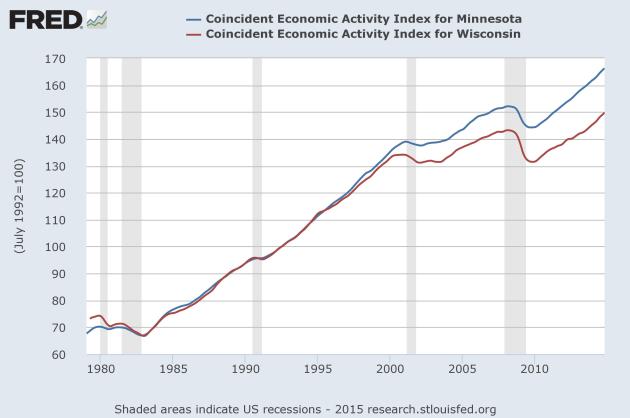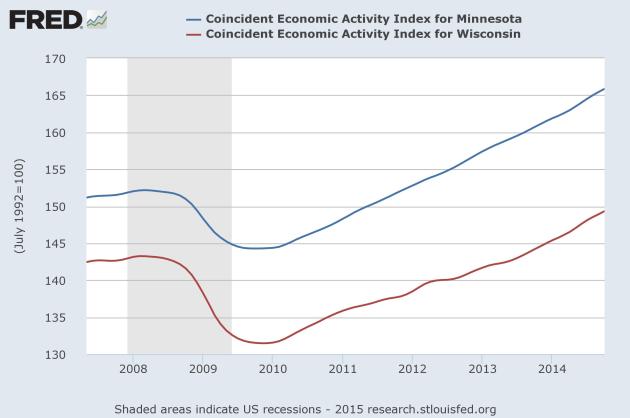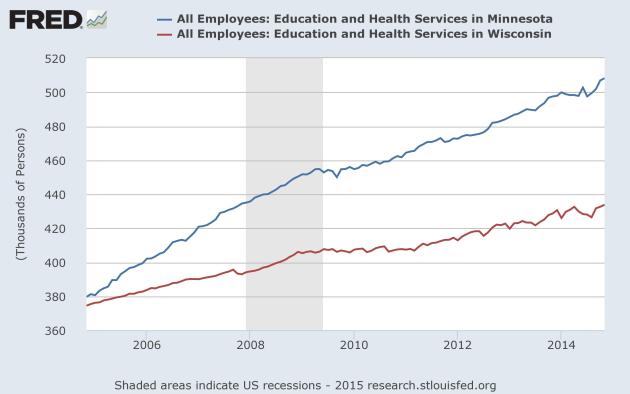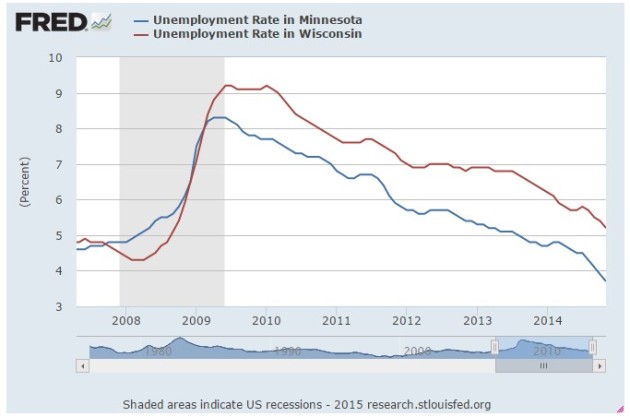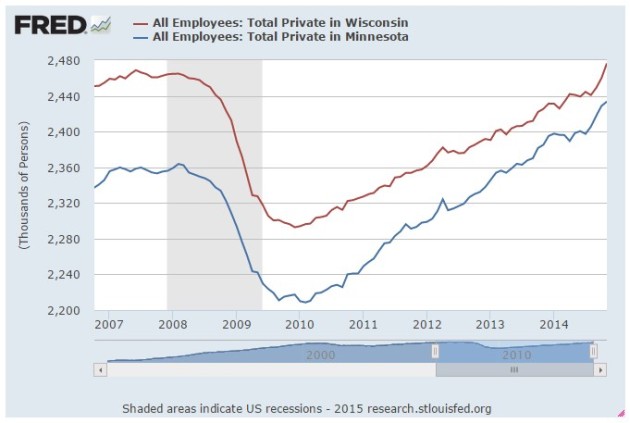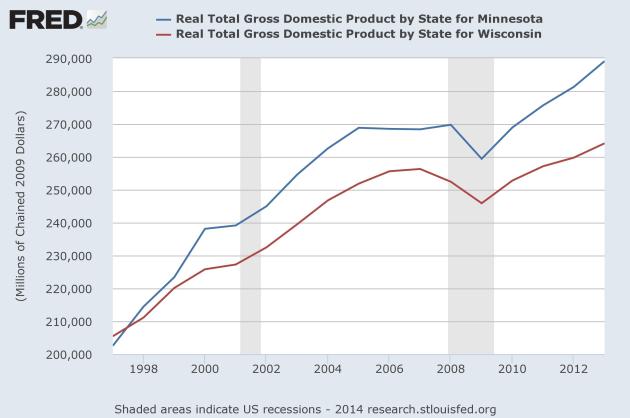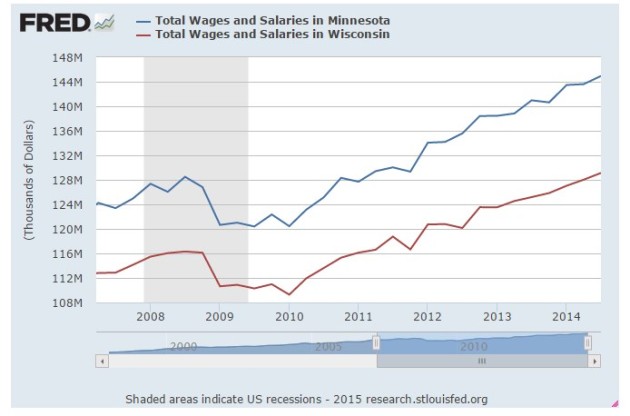Minnesota’s economy outperforms Wisconsin’s economy. The trends have accelerated since the end of the Great Recession. Economically, Minnesota continues to pull away from the Badger State.
Those facts haven’t changed in the four years (Yeesh!) that I’ve been pointing it out.
This is, in fact, the four-year anniversary of my first post on the matter. To commemorate, we’ll look at seven charts and one table that say, collectively: Goodbye, Wisconsin.
Coincident Economic Activity
This index is a good apples-to-apples economic comparison created by the Federal Reserve Bank of Philadelphia. It combines four indicators (nonfarm payroll employment, average hours worked in manufacturing, the unemployment rate, and inflation-adjusted wages) into a single statistic.
Minnesota and Wisconsin ran neck-and-neck for years, then Minnesota started to pull away in the late 1990s.
That trend has accelerated since the Great Recession. Minnesota is leaving Wisconsin behind.
So there’s not much room anymore to debate which economy is performing better. Now, let’s ask why.
Health, education jobs
It’s not completely the reason Minnesota is outpacing Wisconsin, post-recession. But it’s huge.
Much of that was driven by Minnesota’s health care industry, from hospitals to ambulatory care and other services. As we’ve noted before, that job growth saved Minnesota’s bacon in the Great Recession. It continues to drive Minnesota’s post-recession success.
Hard to believe that 10 years ago Minnesota and Wisconsin had nearly an equal number of health and education jobs. As of November, Minnesota had 74,000 more.
Unemployment rate
This is not my favorite statistic. Each month when we report this data, a colleague of mine reminds me that this stat does a lousy job showing the state’s true labor picture. He’s right. But it is widely followed and it serves as another reminder of how Minnesota has recovered and Wisconsin has not.
Yes, in October 2007, two months before the official start of the Great Recession, Minnesota and Wisconsin had nearly identical unemployment rates.
Minnesota catching up to Wisconsin in total jobs
Wisconsin has a larger population than Minnesota, so it makes sense it would employ more people. But change is coming. And this is not about Minnesota adding government jobs.
At the start of the recession, Wisconsin had about 108,000 more private sector jobs than Minnesota. Minnesota has closed that gap dramatically in the recovery. It’s about 42,000 as of November and was as low as 31,000 in September.
It will not be surprising to see Minnesota eclipse Wisconsin in a few years. As the graph above shows, Minnesota recovered its pre-recession private sector jobs nearly two years ago. Wisconsin recovered two months ago.
GDP muscle
As you might expect, all the jobs and other economic activity are good for Minnesota’s gross domestic product, the value of all goods and services produced here.
In this graph, it’s easy to see Minnesota left Wisconsin in the dust, post-Great Recession.
Minnesota’s real GDP came in at $17.4 billion more than Wisconsin in 2008. By the end of 2013, the gap had widened to $25 billion.
And with private sector jobs and GDP in Minnesota growing faster than Wisconsin, it makes sense that Minnesota would also be stronger when it comes to wages and salaries.
So, there you go.
Usually, at this point people want to talk politics. Are we cherry picking data that makes Wisconsin Gov. Scott Walker look bad? Did Gov. Mark Dayton’s tax and budget plans lay the groundwork for this success?
No and no.
My view has always been that we overstate the effects of fiscal policy.
Really, the job makeup of the two economies is remarkably similar. Here’s a breakdown by major sector of Minnesota and Wisconsin employment as of October.
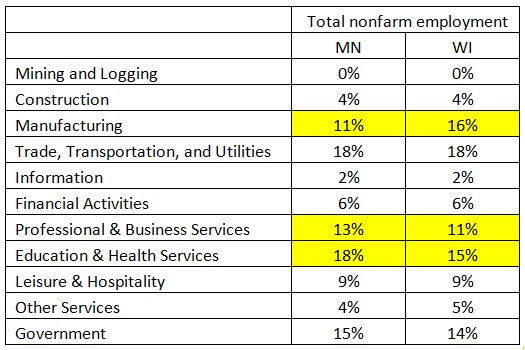
Essentially, Minnesota has an advantage over Wisconsin in key growth sectors — education, health services and professional and business services. (Those sectors have also driven U.S. job growth, as the Wall Street Journal reported recently.) Wisconsin has a bigger stake in manufacturing, which has been in steady decline for years as a jobs creator. The Great Recession accelerated those changes and Minnesota benefited.
“Business environment” rankings go up and down. Taxes and services are cut and added and cut again. Politicians spend lots of energy trying to lure businesses with tax breaks and “open for business” slogans.
But here’s what Forbes magazine highlighted when it listed Minnesota No. 9 in its 2014 ranking of best states for business:
Minnesota cracks the top 10 for a second straight year based on a strong current economic climate and quality of life. The Minneapolis-St. Paul metro area is home to 62% of the state’s population.
It is also serves as the state’s economic hub, with companies such as Target, U.S. Bancorp, General Mills, 3M and Medtronic headquartered there. Minnesota has the fourth highest percentage of adults with a high school degree at 92.4%.
With its good schools, low poverty rate and healthy populous, the state ranks second overall on Forbes’ quality of life measurements.
Wisconsin, by the way, came in at No. 32.
Yes, it’s more about a region’s quality of life, education and workforce. Those fundamentals tend to lure people with ideas. People with ideas tend to build a diversified, thriving economy.

